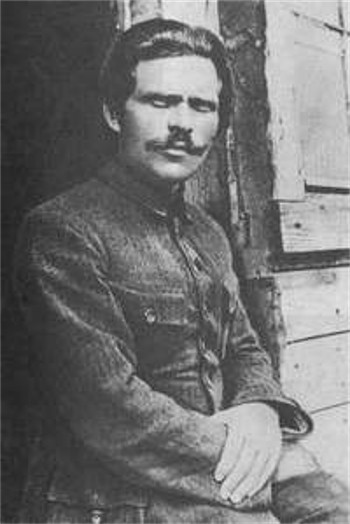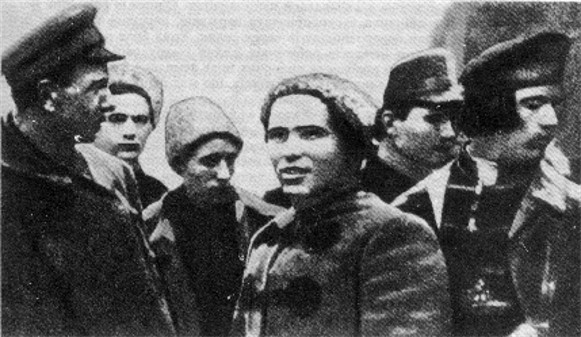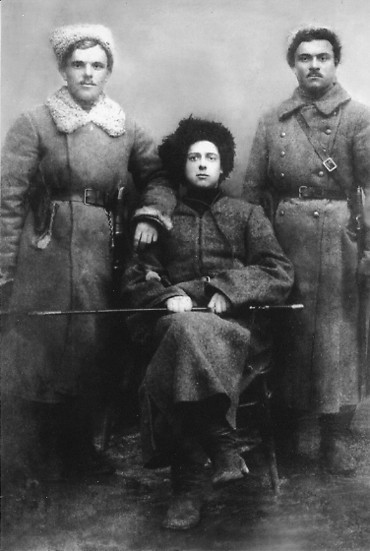Partisan movement in Ukraine, 1918–22
Partisan movement in Ukraine, 1918–22. As government and public order in the Russian Empire dissolved after the February Revolution of 1917, a host of partisan groups sprang up in Ukraine. Differing in size and political orientation, they never formed a unified force behind a single leader or program and often switched their support from one to another of the major contenders for control of Ukraine. Formed mostly from among the Ukrainian peasantry, the movement defended the broad social and political goals of the revolution and sided increasingly with the national aspirations of the Ukrainian people. After the defeat of the Army of the Ukrainian National Republic, the partisan movement became the chief opponent of Bolshevik power in Ukraine.
The first partisan groups were formed in 1917 in the Kyiv region to defend the local population from roving bands of soldiers returning from the front. The peasant brigades that arose from some of these groups, such as the Tarashcha, Zvenyhorodka, and Uman brigades, took part in resisting the Bolshevik offensive on Kyiv in January–February 1918. Maintaining contact with army units loyal to the Central Rada, these brigades operated in the rear of the Bolshevik forces until April.
During 1918 numerous peasant revolts broke out against the German occupational authorities and the Hetman government in Ukraine. The peasants reacted with violence to forced food requisitions and the return of estates to their former owners. The largest rebellion flared up in the summer in the southern part of Kyiv gubernia (Tarashcha, Zvenyhorodka, Skvyra, Uman, and Kaniv counties) and was put down only with the help of a German corps (see Tarashcha uprising). Some partisan operations against the Hetman were instigated by Bolshevik agitators, but they failed to attract wide peasant support. In November–December over 100,000 peasant partisans took part in the overthrow of the Hetman government, which was organized by the Ukrainian National Union.
The partisan movement in Ukraine grew rapidly in 1919. Some partisan units reached sufficient strength to have a decisive influence on the struggle for power among the main protagonists. Nykyfor Hryhoriv's support of the Red Army in February–April was a key factor in its successful offensive against the Whites and the Allies in southern Ukraine. Danylo Zeleny's revolt against the Directory of the Ukrainian National Republic impaired its control of the Kyiv, Chernihiv, and Poltava regions. Nestor Makhno, who established a brief and uneasy alliance with the Bolsheviks in March, inflicted six months later a harsh defeat on Anton Denikin's army, which forced the Whites to abandon their planned offensive on Moscow and to retreat before the Red Army. At the height of his power Makhno commanded a force of 40,000 men and controlled about a third of Ukraine's present territory.
The Bolshevik occupation of Ukraine met with considerable popular resistance in March–June 1919. Heavy requisition of food destined for Russia, Cheka terror, and the Bolshevik land policy provoked widespread revolts. Later, Bolshevik leaders admitted the extent of partisan opposition: according to Khristian Rakovsky, between 1 April and 15 June there were 328 anti-Bolshevik revolts in Ukraine, and according to Volodymyr Antonov-Ovsiienko, in April and May peasant unrest in Kyiv gubernia, Chernihiv gubernia, Podilia gubernia, and Volhynia gubernia tied down 21,000 Red Army troops. Large anti-Bolshevik detachments were led by otamans, such as Ananii Volynets, I. Romashko, and P. Sokolovsky. Many of the instigators of the peasant unrest were Socialist Revolutionaries (SRS) and members of the Ukrainian Social Democratic Workers' party (Independentists), who wanted an independent socialist Ukrainian republic. In April these parties established in Skvyra the All-Ukrainian Revolutionary Committee, the Supreme Insurgent Council, and the Supreme Insurgent Staff to co-ordinate the anti-Bolshevik insurrection. The committee was dissolved in July to allow the Bolsheviks to concentrate their forces against Anton Denikin's offensive. Many of the committee's insurgent groups transferred their support to the Army of the Ukrainian National Republic. A regiment of Nykyfor Hryhoriv's partisans (3,600 men) after his death broke through the Bolshevik front and under Yurii Tiutiunnyk's command formed the Kyiv Group of the UNR Army. In September, Otaman Danylo Zeleny recognized the authority of the Directory of the Ukrainian National Republic. At the beginning of the month the UNR government set up in Kamianets-Podilskyi the Central Ukrainian Insurgent Committee to co-ordinate partisan activity. The committee was chaired by Nazar Petrenko and supported by the SRS, the Ukrainian Social Democratic Workers' party, and the Peasant Association.
In the summer and fall of 1919, as Bolshevik power in Ukraine declined, the partisan movement turned against Anton Denikin's forces, which occupied the territories abandoned by the Bolsheviks. The reactionary social policies of the Whites, their exploitation of the peasants, and their repression of Ukrainian activists provoked spontaneous and uncoordinated mass insurrection. Some of the partisan bands were organized by the Bolsheviks or their sympathizers. The larger and more powerful groups were led by Danylo Zeleny, Andrii Huly-Hulenko, and Nestor Makhno. Partisan activity in his rear undermined Denikin's offensive and enabled the Red Army to score a decisive blow against him at the end of 1919.
The re-established Bolshevik regime was regarded as foreign by most of the population and encountered strong resistance. Generally, the countryside was controlled by partisan bands, and Soviet power remained confined to the towns. During its First Winter Campaign (December 1919–May 1920) the Army of the Ukrainian National Republic tried to unite the various partisan groups in a common uprising against the Bolsheviks. It made contact with Otaman Chuchupaka's forces in Kholodnyi Yar, Otaman Zabolotny's detachments at Balta, and the larger, well-disciplined units of Andrii Huly-Hulenko in the Yelysavethrad region. There were many other sizable bands besides these, including A. Bondarenko's in the Zvenyhorodka region, Kuzmenko-Tytarenko's around Tarashcha, Fotii Meleshko's around Yelysavethrad, and I. Sokil's near Cherkasy. In the summer of 1920 the Cheka chief F. Dzerzhinsky was sent from Moscow with 6,000 special Cheka troops to deal with the partisan problem. In Kyiv gubernia there were 11 peasant revolts in June, 51 in July, and 106 in August, and in Poltava gubernia there were 76, 99, and 98, respectively. Vladimir Lenin admitted as late as October 1920 that Soviet control of Ukraine was formal rather than real.
At the beginning of 1921 there were about 40,000 partisans in Ukraine. The largest force was Nestor Makhno's in southern Ukraine, but several bands numbered 500 or more men: those under Struk, Sirko, and Yakiv Mordalevych (in Kyiv gubernia), Loshyn (Chernihiv gubernia), Yurii Tiutiunnyk (Volhynia gubernia), Holub (Podilia), Shuba (Poltava gubernia), and Burlaka and Siroshapka (Kharkiv gubernia). In March 1921 the Bolshevik regime offered amnesty to insurgents who surrendered voluntarily. By September 1922, 200 otamans and 10,000 men had surrendered. With the suspension of Soviet-Polish hostilities and the defeat of Petr Wrangel's army, the Bolsheviks redirected their forces in early 1921 against the partisan movement. Using Mikhail Frunze's tactics of ruthless executions, they launched a wide clearing campaign. In 87 operations during April and May they reportedly killed 5,000 and captured 4,200 partisans, and destroyed 28 bands. In June they eliminated the All-Ukrainian Insurgent Committee headed by Bondarenko in the Bratslav region and the Ukrainian Central Insurgent Committee headed by Ivan Andrukh in Kyiv. By the end of the summer the main partisan groups were crushed, although small, sporadic revolts continued to break out. The Ukrainian National Republic government's last attempt to spark a general insurrection against the Bolshevik regime—the Second Winter Campaign, led by Yurii Tiutiunnyk in October and November 1921—ended tragically, with the execution of 359 soldiers at Bazar.
The partisan movement in Ukraine demonstrated the deep hostility of the Ukrainian peasantry to any foreign invader and particularly to the Bolshevik regime. It also made the Soviet rulers permanently suspicious about Ukraine's loyalty.
BIBLIOGRAPHY
Khrystiuk, P. Zamitky i materiialy do istoriï ukraïns’koï revoliutsiï, vols 3–4 (Vienna 1921; repr, New York 1969)
Tiutiunnyk, Iu. Zymovyi pokhid 1919–1920 rr. (Kolomyia 1923)
Antonov-Ovseenko, V. Zapiski o grazhdanskoi voine, vols 2–4 (Moscow 1928–32)
Mazepa, I. Ukraïna v ohni i buri revoliutsiï, 1917–21, vols 1–2 (Prague 1942), vol 3 (Neu-Ulm 1951)
Likholat, A. Razgrom natsionalisticheskoi kontrrevoliutsii na Ukraine, 1917–1922 gg. (Moscow 1954)
Adams, A.E. Bolsheviks in the Ukraine: The Second Campaign, 1918–1919 (New Haven–London 1963)
Kucher, O. Rozhrom zbroinoï vnutrishnoï kontrrevoliutsiï na Ukraïni u 1921–1923 rr. (Kharkiv 1971)
Borys, J. The Sovietization of Ukraine, 1917–1923: The Communist Doctrine and Practice of National Self-Determination, rev edn (Edmonton 1980)
Malet, M. Nestor Makhno in the Russian Civil War (London 1982)
Stepan Ripetsky
[This article originally appeared in the Encyclopedia of Ukraine, vol. 3 (1993).]



